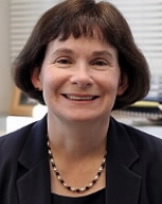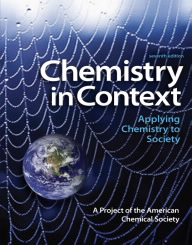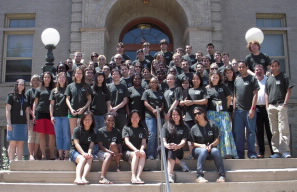The Chemistry is Always Greener…
By Dr. Mary Kirchhoff, ACS Education Division Director
The word “green” conjures up environmental images—grass, trees and eco-friendly products. Green is everywhere, from green buildings to green cleaning products, even green vacations. As chemists, we focus on green chemistry, the design of chemical products and processes that reduce or eliminate the use and generation of hazardous substances. Green chemistry is not a separate field of chemistry as much as it is an approach to the practice of chemistry, because protecting the environment is the responsibility of every chemist.
Green chemistry is guided by 12 principles that focus a chemist’s thinking when designing new products and processes. Do you really need to use a volatile organic solvent in running a reaction—will safer alternatives work or is a solvent needed at all? What is the source of your starting material? What happens to your final product; does it persist in the environment or degrade into harmless products? How much and what type of waste is generated? These are the types of questions that green chemistry fosters, questions that are applicable to all areas of research.
Green Chemistry and Sustainability

ACS is committed to sustainability as reflected in its mission, “To advance the broader chemistry enterprise and its practitioners for the benefit of Earth and its people.” This commitment is evident in the Society’s operations. Last month, the U.S. Green Building Council designated the ACS Othmer Building in Washington, DC, as Platinum LEED (Leadership in Energy and Environmental Design) certified; it is one of only nine buildings so designated in the entire country.
Green chemistry is our discipline’s unique contribution to sustainability, which is commonly defined as “meeting the needs of the present without compromising the ability of future generations to meet their own needs.” Only by designing chemical products and processes that are beneficial to the planet will we be able to meet the material needs of the expanding global population. Much of the world’s population lacks safe drinking water and is in desperate need of a portable, low-cost water purification system. The shift from fossil-based fuels to more sustainable energy sources that are less damaging to the environment is a national research priority. Higher food production can be realized using pesticides that minimize harm to beneficial organisms. Meeting these global challenges depends upon chemistry and upon chemists who recognize the environmental impacts of their work and are able to design and implement cleaner products and processes.
Green Chemistry Education

Green chemistry is steadily making its way into the classroom and laboratory. Textbooks often highlight green chemistry examples in sidebars or text boxes, but the ACS texts Chemistry in the Community and Chemistry in Context will more fully integrate green chemistry throughout the new editions to be released in 2011. The Journal of Chemical Education publishes experiments and classroom activities through its green chemistry feature.
A number of colleges and universities offer green chemistry courses and emphasize green chemistry in research. The University of Oregon, for example, offers a fully green organic chemistry laboratory curriculum and plays a key role in disseminating green chemistry resources through its GEMs (Greener Educational Materials) database. Oregon also introduces faculty to green organic laboratory protocols through its annual NSF-sponsored summer workshop. Queen’s University in Ontario recently launched GreenCentre Canada, which transforms fundamental research into sustainable products and processes, a model of academic–industrial collaboration. Green chemistry is not limited to research universities, however. Primarily Undergraduate Institutions, like Hendrix College in Arkansas and St. Olaf College in Minnesota, offer courses and research opportunities focused on green chemistry, as do two-year colleges, such as Lane Community College in Oregon. High schools are also embracing green chemistry, adopting experiments that increase safety while decreasing waste.
ACS Summer School on Green Chemistry and Sustainable Energy

One way that ACS promotes green chemistry among graduate students and postdoctoral scholars is through the annual ACS Summer School on Green Chemistry and Sustainable Energy. Approximately 60 participants from the United States, Canada, and Latin America spend 7–10 days learning about green chemistry and sustainable energy through lectures, laboratories, poster sessions, discussions, and case studies. Fun is also on the agenda - soccer, line dancing, and karaoke have made appearances at past green chemistry summer schools!
The Summer School has been held annually since 2003 in such locations as Montevideo, Uruguay; Pittsburgh, Pennsylvania; Mexico City; Montreal; and for the past three years at the Colorado School of Mines in Golden. The ACS Petroleum Research Fund is generously supporting the 2011 Summer School, which will return to McGill University in Montreal. Prior experience in green chemistry is not required, simply an interest in learning more about sustainable energy and green chemistry. I invite you to apply for this exceptional opportunity at www.acs.org/greenchemistry/education, where you can download the application from the Summer School link (application deadline: March 13th). I look forward to seeing you from June 26–July 3 at the Summer School in Montreal!
Dr. Mary Kirchhoff is Director of the Education Division at the American Chemical Society and former Assistant Director of the Green Chemistry Institute. As the recipient of an AAAS Environmental Fellowship, she worked with the U.S. EPA's green chemistry program. She is also a coauthor with Paul Anastas and Paul Bickart on Designing Safer Polymers and coeditor with Mary Ann Ryan of the ACS' Greener Approaches to Undergraduate Chemistry Experiments. She received her Ph.D. in Organic Chemistry from the University of New Hampshire.

(Photo credit: Mary Kirchhoff)

